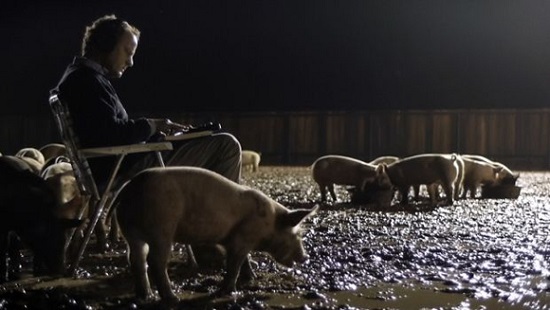If large-scale studio films are a triumph of collaboration, with casts of thousands both in front of and behind the camera, the indie sector is its ideological inverse: victories of utter individualistic control. This is relevant when trying to make sense of Upstream Colour and Primer’s talented Texan director Shane Carruth. It’s as if Carruth fired every employee in his little boutique factory, opting to twist every lever, and lick every envelope himself. Not since the silent era have we seen a director quite as enthusiastically multi-hyphenate: Carruth writes, directs, edits, scores and organises central distribution for his cerebral and ideas-packed sci-fi gems (he even schedules his own press interviews). It’s a vision of independent film production as the ultimate creative power-trip, complemented and enabled by Carruth’s technical background: self-taught as a director, he was an engineer and maths graduate before catching the film bug. The self-perpetuating logical loops of his film’s stories resemble perfectly realised experiments and hypotheses, only here drawn out upon a cinematic canvas, as opposed to being devised for the sort of limiting corporate commissions that the scientist and analyst protagonists in his films always seem to be running away from.
Primer, his 2004 time-travel mini-masterpiece, was like a virtuoso engineering workshop with future Nobel laureates; an effort to make the lightbulb flash inspiration of discovering time-travel feel somewhat plausible and authentic. But unlike The Terminator or Back to the Future, it grappled with the format’s uncomfortable ethical questions: the physicists at the film’s centre had summoned an invention too powerful to conceal, but liable to be dangerously abused. Suiting the inventors’ monkish, workaholic perfectionism, it was an aloof, chilly film, but one bursting with rewarding secrets for viewers willing to learn its language. Upstream Colour, which, like its predecessor, premiered to warm notices at this year’s Sundance Film Festival, makes similar demands upon its viewers to decipher its evasive plot threads. Marking a vast advance in Carruth’s filmmaking technique, with audacious formal gestures subbing for modest economy at every turn, the tone of Upstream Colour is sensuous, tactile and delicate, trading in Primer’s skewed physics for hallucinatory biology. The focus of this new film follows each stage in a cross-species life-cycle, one that privileges plants and animals on the same plain as their human subjects.
The film begins by showing a character known simply as The Thief (Thiago Martins) using the cycle’s potential as a means for crime. He kidnaps a 3D graphics designer, Kris (Amy Seimetz, superb), and forces her to ingest a psychotropic worm that leaves her hypnotised and compliant. He then steadily proceeds to drain her of her savings, mortgage and possessions. A mysterious sound engineer, The Sampler (Andrew Sensenig), takes further control of Kris by using his trance-inducing resonant sound waves to draw her into his pig farm on the outskirts of the city. The Sampler then conducts a blood transfusion between Kris and a pig, transferring the worm into a new host. A telepathic connection is formed between pig and human, with the Sampler free to spy on Kris’s inner world by marshalling the pigs with sound-wave commands. After undergoing an unspeakably traumatising and bizarre episode (for us and her) she meets Jeff (Carruth again), whom she immediately discovers underwent a similar experience. As they attempt to readjust to the normal rhythms of life, The Sampler’s menacing auditory influence emerges again, challenging the assumption of their own free will.
So far, so weird. Yet the film’s fast-flowing and opaque imagery invites the viewer to be more participatory than normal. Often dialogue altogether is foregone; like a latter-day Terence Malick, Carruth discloses key information wholly through his visual storytelling, asking us infer meaning from his repeated drip-fed motifs – the worms, the paper chains made up of quotations of Thoreau’s Walden, Seimetz’s carefully modulated expressions. Combined with a hymnal, part-orchestral, part-synthesised score, the effect of all this peculiar, incongruous information being propelled at us has an overwhelming emotional charge. The effect is like being broadcast by osmosis a hidden, organic truth about the order of the natural world, unveiling the inherent connection between all things. Carruth’s genius in this film is making us take seriously his eccentric juxtapositions, between men and women, human and animal, parasites and plants. He’s too sincere to ally them anything cynically attention-seeking, or for camp-bizarro value. Having seen the film twice now, the execution isn’t immune to flaws: ironically unlike Primer, it doesn’t especially reveal new depths with repeated exposure, with the effect of replaying the cycle only clarifying its specific stages rather than provoking greater meaning. And Carruth’s insistence in interviews that the cycle amounts to a grounded, logical template asserts that there’s a ‘correct’ and ‘incorrect’ way to grasp the film, which shows that he’s prone to misconstruing the symbolic potency of his own images. Of course, we have to cherish that this film, and his work overall, offers us something radical and new: a cinema of the brightest ideas, realised with as much respect for the science as the ‘fiction’.
Upstream Color is in selected cinemas now


